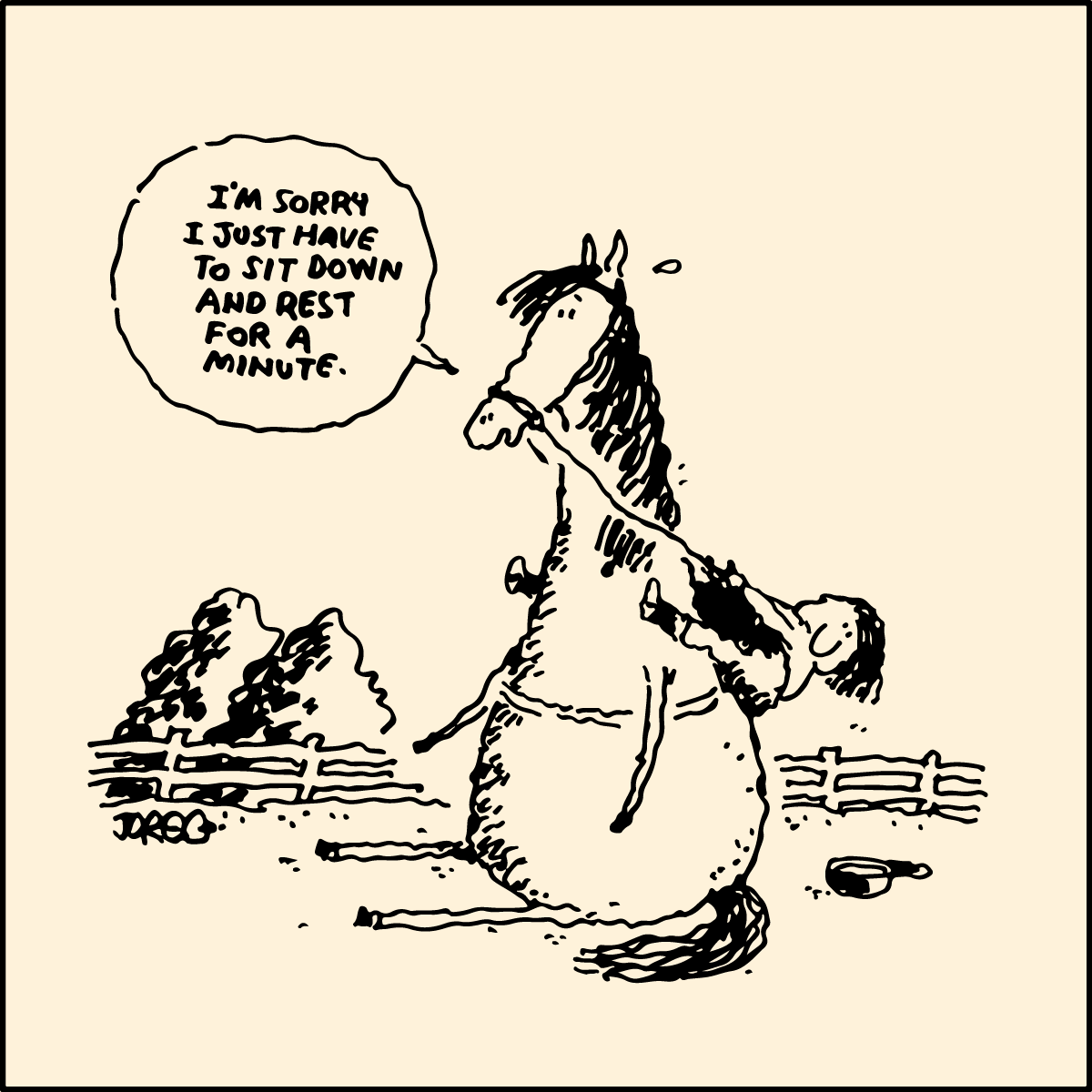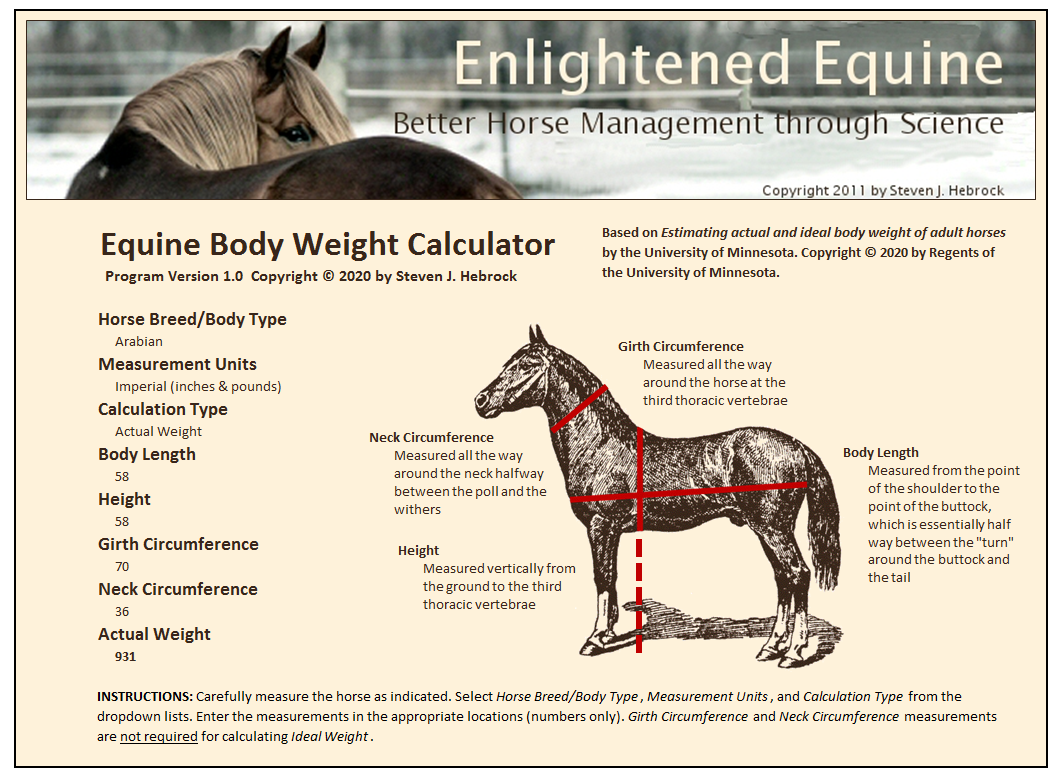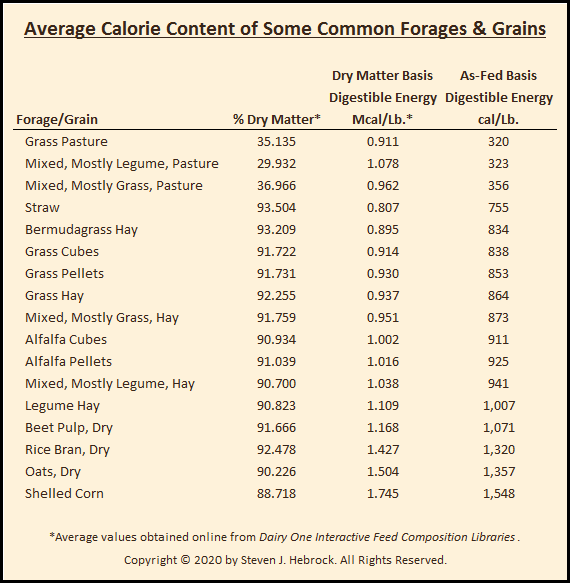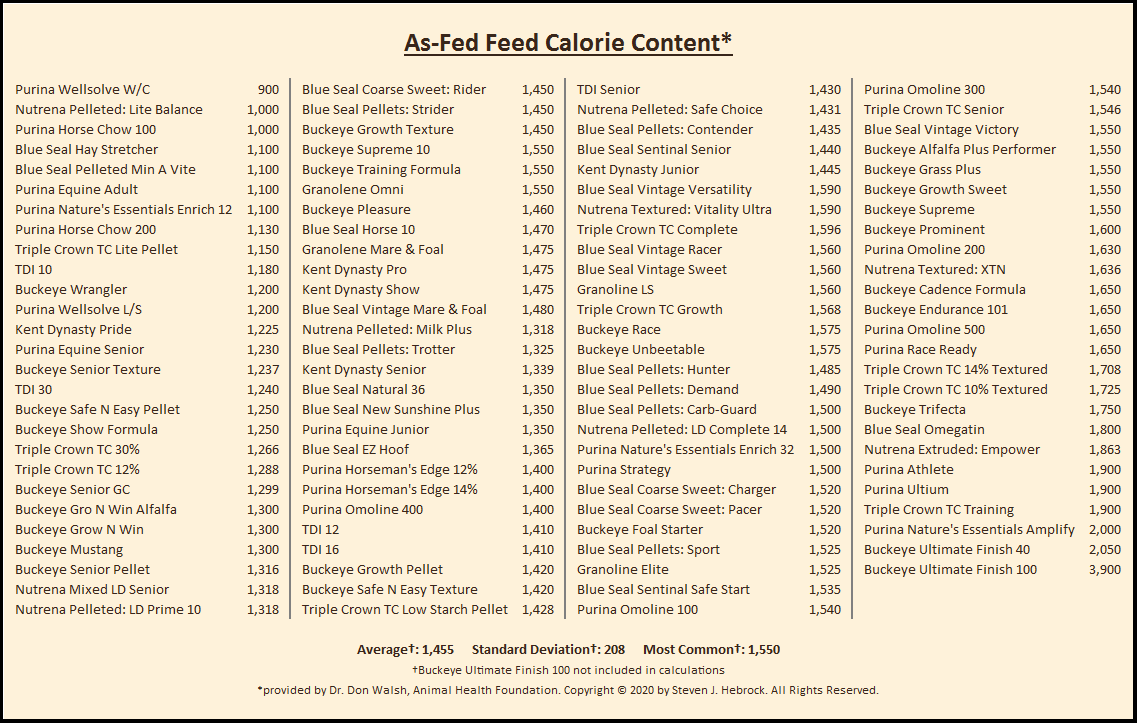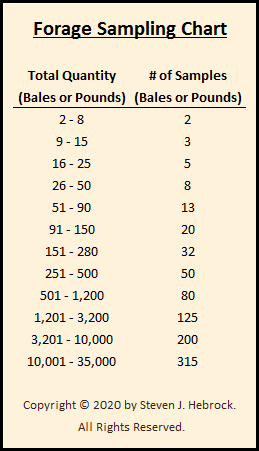UPDATE: I happened across some new information on approximating current and ideal (target) body weight based on research done at the University of Minnesota. Because they use different formulae for different body types, their method appears to yield more precise approximations than previous methods, so my advice would now be to use their method to determine the target weight for your horse. You can find a description of their research and method here; note they also have an app available for Apple and Android devices at a minimal cost. I decided to create my own MS Excel-based calculator using their formulae that can be used or downloaded from here at no cost. Here’s a preview –
Humorous as Jared Lee’s cartoon may be, the overweight horse is genuinely at risk for increased health and performance problems. Overheating, poor performance, and metabolic disorders are all common consequences of excess body fat, causing discomfort, pain, and even loss of use for your horse, plus costly vet bills, headache, and heartache for you as the owner.
In Calories 101 – Part 1, we looked at several methods for estimating a horse’s current and target weights, and calculated the total number of calories necessary for maintaining a horse’s ideal body weight. And now, equipped with that necessary information, we can next take on the task of planning a proper diet for your horse. But first, I want to reiterate that I’m not an equine nutritionist; I’m merely a guy with an extensive math background who understands and can explain how to do the well-established calculations necessary for the task at hand! For advice about specific nutrients and nutrient ratios, please consult an equine nutritionist – ideally (in my opinion), one at a university, who’s not likely to be employed by the feed or supplement industries, to minimize the possibility of any specific product biases. So let’s get started!
First of all, absolutely everything in diet calculations is measured by weight. Not flakes, scoops, coffee cans, bales, pudding containers, or anything else volume-related. Weight. Period. So you’ll need some reasonably-accurate method of weighing out forage and feed. Yes, we could do some get-it-in-the-ballpark volume-based “guesstimating,” and possibly get within a factor of 2 by the time we figure out the actual amounts to feed, but why knowingly add to the already-present inaccuracies in horse weight and exercise estimations? You’ll need probably two different scales – a small platform-style scale (like a kitchen or postage scale) to weigh feed, and a hanging scale (like a fish scale) with a bag or hay net to measure forage.
When we talk about things that go in your horse’s mouth, it’s important to understand the difference in calories between what we’re actually feeding the horse, known as as-fed basis, and the values listed on any sort of analysis, called dry matter basis. The idea is a simple one: Everything your horse eats contains some amount of moisture. Whether it’s cured hay, with a relatively small water content of around 8 – 13%, or grass pasture, with much higher moisture values of 60% or more, that water needs to be accounted for in any calculations. So for an apples-to-apples comparison, dry matter basis is the way to go!
Our calorie estimations depend on two numbers listed in an analysis: the digestible energy (DE), which is a measure of the number of megacalories per pound in the sample, and the percentage of dry matter (% Dry Matter) present in the sample. For example, suppose my hay sample analysis results state that all figures are on a dry matter basis, and list a DE (Digestible Energy) of 1.000 Mcal/Lb. and a % Dry Matter of 90.000. Since the DE on my report is listed as a dry matter basis figure (in other words, with no water), but what I actually feed contains water, I need to do a bit of math to figure out how many calories are in a pound of what I’m actually feeding. First of all, 1.000 Mcal is equal to 1,000 calories; we have to multiply by 1,000 (i.e. move the decimal point 3 places to the right) to convert megacalories to kilocalories, which are what we usually refer to as just “calories.” Next, we have to multiply the calories by the % Dry Matter to figure out how many calories are in an as-fed pound of hay, so 1,000 × 0.90 = 900 calories per pound. The easy way to help remember that you need to multiply rather than divide is that the as-fed calories will always be lower than the dry matter calories. And now I know how many calories are in a pound of my hay!
So we’ll begin by talking about how to plan a diet using already-provided average values for forage and feed, and then we’ll describe how to properly collect and prepare a forage sample for actual laboratory analysis. And this seems like an appropriate time to mention my general approach to feeding horses.
As with hoof care, I believe our feeding perspective should emulate nature’s process of feeding feral horses in their aboriginal environment to the extent possible. Even though our horses’ energy (calorie) needs may at times exceed those of the feral horse, what they eat and the method of delivering it can still be consistent with nature’s methods. By doing so, we can minimize or even eliminate most of the feeding-related problems; laminitis, choke, insulin-related metabolic issues, and colic are all examples of conditions most properly-fed horses rarely suffer from. So keep this in mind as I describe the diet planning.
The table below lists the average DE and % Dry Matter values for some of the most common forages and grains, including fresh forages like grass pasture. These values come from a fabulous and absolutely free resource: Dairy One’s Interactive Feed Composition Libraries. While not every possible thing you might want to feed your horse can be found in their libraries, most typical items – and even some seemingly-odd ones (for horse people) like fresh pineapple forage – are definitely provided! And, being the nice guy that I am, I’ve calculated the As-Fed Basis DE calories as well –
Let’s begin with dry forage (hay), since that’s crucial to every horse’s digestive health, and should by far constitute the largest percentage of any horse’s diet. The absolute minimum amount of forage required to keep a horse’s digestive system working properly is considered to be 1% of his Target Weight per day, on a dry-matter basis. That means my 15-hand horse with an ideal weight of 1,014 pounds needs at least 1,014 × 0.01 = 10.14 pounds of dry-matter-equivalent forage each and every day just to keep things operating properly. According to the above table, grass hay has a % Dry Matter of 92.255, so the easiest conversion to as-fed would be 10.14 ÷ 0.92255 = 11 pounds. Remember, the as-fed amount will always be higher than the dry-matter basis amount, so dividing by the percentage of dry matter gives us the increase in weight due to water. The table also lists an average digestible energy (DE) content of 864 calories per pound, so feeding the absolute minimum forage requirement for my 15-hand horse would provide only 11 × 864 = 9,504 calories. But if you remember from Part 1, my 15-hand horse requires 15,210 calories per day to maintain his target weight, so we have a calorie deficit of 15,210 – 9,504 = 5,706 calories. So let’s see how much additional grass hay I would need to take care of this deficit.
If we divide the deficit by the average as-fed DE for our grass hay, we have 5,706 ÷ 864 = 6.6 pounds. So, by feeding my horse 11 + 6.6 = 17.6 pounds of grass hay per day, we’ve provided all of the calories necessary for him to maintain his Target Weight – no other feed required! Admittedly, that was more complicated than it needed to be, because directly computing the forage amount from the required calories will always more than satisfy the 1% requirement. So, making certain to use appropriate values to end up with as-fed weight:
Required Calories per Day ÷ Digestible Energy per Pound of Forage = Required Pounds of Forage per Day, or
15,210 ÷ 864 = 17.6 pounds
Simple enough, right?
…but now I need to mention there are several caveats to keep in mind when using the information. Keep in mind that the Digestible Energy number, like all of the numbers, is an average value based (in this case) on 66,310 samples, and, in reality, the values can and will vary over a fairly wide range. For grass hay’s DE, for example, those samples had a Standard Deviation of 111 calories. Without getting into the statistics behind these numbers, let me just say this indicates that 95% of the samples tested actually had a DE somewhere between 715 and 1,159 calories per pound (dry matter basis), or 660 and 1,069 calories per pound as-fed. Let’s try to understand the implications of that on our simple feeding program.
If you feed the originally-calculated 18 pounds of grass hay (yes, I rounded it up to the nearest pound) per day which used the average DE for the calculation:
18 × 660 = 11,880 calories per day with a DE at the lower end of the samples, leaving a deficit of 3,330 calories and thus underfeeding the horse by 22%
18 x 1,069 = 19,242 calories per day with a DE at the higher end of the samples, creating a surplus of 4,032 calories and thus overfeeding the horse by 27%
Conversely, if you adjust the forage amount for the lower and higher ends of the samples:
15,210 ÷ 660 = 23 pounds per day will be required if the hay is actually at the lower end of the samples measured
15,210 ÷ 1,069 = 14.23 pounds per day will be required if the hay is actually at the higher end of the samples measured
This same variability, of course, is present in the % Dry Matter numbers as well; more or less water present than the average value will have a potentially serious effect on the calculated as-fed amounts, thus throwing your feeding program off even farther! Hopefully, you’re starting to understand from this example why it’s so important to have your hay tested; you could very easily be underfeeding or overfeeding by a significant amount if your hay’s DE and % Dry Matter aren’t very close to the averages! Fortunately, hay testing is very easy and inexpensive, and will provide an in-depth look at the composition of your hay. A basic analysis from Dairy One, for example, will cost you only $23, and they’ll provide you with a postage-paid mailer for the sample, and email you the test results in very short order. The international handling fee is only an additional $7. Well worth the money! On to feed…
As we just saw in the above calculation, we were able to meet the calorie requirements of my 15-hand horse with 18 pounds of grass hay per day, and no other feed or grain. Horses are able to eat upwards of 2% of their body weight in dry matter per day, which translates to:
1,014 pounds body weight × 0.02 = 20.28 pounds Dry Matter
20.28 pounds Dry Matter × 0.937 Mcal/lb. DE = 19,002.36 calories
This means my horse is able to eat enough of this grass hay per day to meet all of his calorie needs even if he were being ridden or driven an hour every single day – no concentrates required! And in keeping with my philosophy about emulating nature’s process of feeding feral horses, let me also state now that I’m not of the opinion that horses should have unlimited access to hay – for a very simple and logical reason: Although feral horses have a theoretical 24-hour access to forage, in reality they must work hard to get that forage. Unlike our domestic horses, who can simply stand in front of a mountain of hay and gorge themselves, feral horses are eating sparsely-spaced dry, bunch grasses, and typically travel just under 12 miles every day to eat enough to satisfy their calorie requirements. While some domestic horses may eventually “self-regulate,” and eat only an amount necessary to meet their daily caloric needs, many others will simply continue to eat in excess – as evidenced by the tremendous number of overweight horses! So, your horse’s hay – whatever the required amount – needs to be parceled out via some slow-feeding method over a 24-hour period, thus emulating nature’s feeding method to the degree possible.
Feeding grain to horses came about at a time in history when horses were being used many hours per day, whether for farming, warfare, or transportation, and simply hadn’t enough time available to consume sufficient forage to maintain their body weight. So the use of “concentrated calories” came about to allow horses to meet their calorie needs and still be able to do heavy work. Unfortunately, that tradition has continued, and many horse owners believe or are told that their horses must eat feed or grain to remain healthy. That’s simply not the case; as you can see, most of our horses’ much lower calorie requirements can easily be met just by feeding hay. And because horses must consume at least 1% of their body weight (dry matter basis) in forage to maintain proper gut function, concentrate manufacturers generally list their feeding recommendations with that 1% forage + maximum concentrate as the starting point, followed by progressively higher amounts of forage + lower amounts of concentrate. Enough of that for now!
The following data was provided to me by Dr. Don Walsh, founder of the now-closed Animal Health Foundation, which supported laminitis research all over the world (thank you, Don!). Don collected this information directly from feed manufacturers because they do not list calories on their products; sadly, you have to contact them for calorie information. This list is by no means comprehensive, but it can give us a pretty good sense of the calories in most concentrates. I’ve listed them in order of ascending calories, as that’s more useful and interesting to me than the specific feed type –
As you can see, there’s quite a range of calorie values here – from a low of 900 to a high of 3,900! Incidentally, the feeds at the lower end are typically forage or ration balancers, which are products designed to make up for forage deficiencies in a particular geographic area. They aren’t intended to be major calorie sources, and are fed at lower amounts than complete feeds. If your forage analysis reveals deficiencies, a ration balancer is the ideal way to make certain your horse’s vitamin and mineral needs are being met without adding a bunch of unnecessary calories to his diet.
Once equipped with the necessary feed calorie information (remember: you may need to call the manufacturer to get it), any feed component in your horse’s diet can be calculated in the same manner. Let’s use the numbers from our previous example: a 15-hand horse with a target weight of 1,014 pound requiring 15,210 calories per day, with 9,504 calories already provided by 11 pounds of grass hay. So if we use the most common calorie value for feed of 1,550 calories per pound (as-fed), our 5,706-calorie deficit can be met by:
5,706 ÷ 1,550 = 3.68 pounds of concentrate
So our entire diet calculates out to be 11 pounds of grass hay plus just under 4 pounds of feed per day. Remember that your horse must have the 11 pounds of hay; that’s a well-established absolute minimum! And with only 4 pounds more of feed – or just under 7 pounds more of grass hay – we’ll satisfy all of his calorie requirements. Anything beyond that is excess calories, which will be converted to fat! Based on what I see and hear on a daily basis, I’m certain these quantities seem quite small to you – especially the amount of feed. But keep in mind that that feeling exactly demonstrates my point: We’re grossly overfeeding our horses!
To wrap up Part 2, let’s discuss how to collect and prepare a forage sample for testing. The first step is to gather an appropriate sample, which needs to be collected in a random manner to be truly representative of our lot of hay. The table below will help you know how many samples to gather to create your final sample for submission –
This particular approach to sampling, including the numbers in this table, is called the Acceptable Quality Limit standard, and dates back to World War II and the manufacture of bullets for the armed forces. It provides a method of determining the characteristics of a group of items by testing a randomly-chosen number of items from that group; how many items need to be tested is a function of the total number of items in the group. For diet planning, the numbers can represent some unit of hay – either bales or pounds probably being the most logical. For example, suppose we buy 100 bales of hay from a dealer. Looking at the table, we see that randomly testing 20 bales will give us a very good idea of the characteristics of the entire 100-bale lot. For our purposes here, we’re interested in the two numbers we’ve been using to plan our horse’s diet: the Digestible Energy (DE) and the % Dry Matter.
I can’t stress the importance of a random sample enough. If we merely test the last 20 bales unloaded, for example, it might turn out they were leftover bales from an earlier crop, and therefore wouldn’t be representative of the entire lot. So we need to be a bit creative in our approach to picking the 20 bales. It’s really not difficult; for instance, as the hay is being unloaded, you could set aside every 3rd, then every 5th, then every 7th bale, repeating that pattern until you had the 20 bales. At any rate, once you have the 20 bales set aside, you need to reach into the center of each of the bales and pull out 2 or 3 handfuls of hay (you could also use a hay probe for sampling, which is like a long, small-diameter hole saw, but it’s not necessary). Take a pair of scissors, cut each of your handfuls into 2- to 3-inch pieces, and combine all of the cut samples in a clean, dry plastic bucket. Thoroughly mix the samples. Weigh out one (1) pound, place it in the sample bag, squeeze out the air, and seal the bag. That’s it!
And rather than have a downloadable file of the tables in this Post, I’ve decided I’ll create an MS Excel spreadsheet that’ll incorporate the content of all 3 parts of this series in one “spot,” and will automatically do all of the calculations for you!
In Calories 101 – Part 3, we’ll tackle what I consider the most challenging part of basic diet planning: the pasture. Stay tuned…
